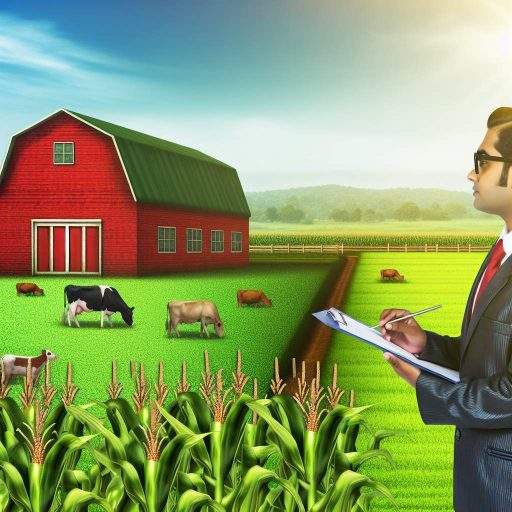Introduction:
As environmental issues continue to threaten the stability of our planet, it has become increasingly important for environmental scientists to utilize technology in farming practices.
By incorporating advanced technologies, these scientists can improve efficiency and sustainability in agriculture, ultimately leading to a greener and more sustainable future.
Precision Agriculture
Precision agriculture is a farming management concept that uses technology to optimize yields and reduce waste.
- It involves collecting data through various technologies to make informed decisions for farming practices.
- By utilizing precision agriculture, environmental scientists can enhance productivity while minimizing environmental impact.
Role of Precision Agriculture
Precision agriculture plays a crucial role in modern farming practices by:
- Improving efficiency in resource utilization such as water, fertilizers, and pesticides.
- Increasing crop yields through targeted application of inputs based on data-driven insights.
Technologies in Precision Agriculture
Environmental scientists leverage various technologies in precision agriculture to enhance farming practices:
- GPS technology enables precise mapping of fields and tracking of farming equipment for optimized operations.
- Sensors collect data on soil moisture, nutrient levels, and crop health for informed decision-making.
- Drones provide aerial imagery to monitor crop health, detect pest infestations, and assess field conditions.
Soil Sensors
Soil sensors are essential tools for monitoring soil health and nutrient levels.
Environmental scientists use soil sensors to gather real-time data on soil conditions.
They help in determining the moisture content, pH levels, and nutrient levels in the soil.
These sensors provide accurate and actionable insights for crop management decisions.
With soil sensors, scientists can optimize irrigation schedules based on actual soil moisture levels.
They help in preventing overwatering or underwatering, which can affect crop yield.
Soil sensors also aid in precision fertilization, ensuring the right nutrients are applied when needed.
By monitoring nutrient levels, scientists can adjust fertilizer application to avoid nutrient deficiencies or excesses.
Overall, soil sensors play a crucial role in sustainable farming practices and environmental conservation.
Explore Further: Plant Pathologists’ Role in Sustainable Farming
Weather Forecasting:
Accurate weather forecasting is crucial for agricultural activities.
Environmental scientists rely on weather forecasting technologies for planning planting, harvesting, and irrigation schedules.
They use advanced weather prediction models to anticipate climate patterns.
Satellite imagery helps in monitoring weather conditions across large agricultural regions.
Real-time data from weather stations enhances the accuracy of forecasts.
Transform Your Career Today
Unlock a personalized career strategy that drives real results. Get tailored advice and a roadmap designed just for you.
Start NowBenefits of Accurate Weather Forecasting:
- Minimizes crop losses due to unexpected weather events.
- Optimizes irrigation schedules for efficient water usage.
- Allows farmers to plan planting and harvesting activities effectively.
- Reduces the risk of diseases and pests that thrive in specific weather conditions.
- Improves overall productivity and profitability of farming operations.
Utilization of Weather Forecasting Technologies:
- Environmental scientists leverage weather apps for real-time updates on weather conditions.
- They use weather radar systems to track precipitation patterns and storms.
- Climate simulation models help in long-term planning for changing weather patterns.
- Satellite technology provides images of cloud cover, temperature, and wind patterns.
- Automated weather stations collect data on temperature, humidity, and wind speed.
Gain More Insights: Horticulture Internships and Volunteer Opportunities
Remote Sensing
Remote sensing is the process of collecting data from a distance without making physical contact with the object being studied.
In agriculture, this technology plays a crucial role in monitoring and managing farm resources effectively.
- Applications in Agriculture: Remote sensing has various applications in agriculture, such as crop health monitoring, yield prediction, pest detection, and soil mapping.
- Monitoring Crop Health: Environmental scientists use satellite imagery to monitor crop health by analyzing plant color, size, and growth patterns. Any abnormalities detected can help identify potential issues.
- Detecting Environmental Changes: By utilizing remote sensing technologies, scientists can track changes in land cover, water availability, and temperature variations. This data aids in making informed decisions to mitigate environmental risks.
- Improving Precision Agriculture: Remote sensing enables farmers to adopt precision agriculture techniques by providing detailed information on crop health, nutrient levels, and irrigation requirements.
- Enhancing Sustainability: Through remote sensing, environmental scientists can monitor the impact of farming practices on the environment and implement sustainable solutions to reduce resource depletion and pollution.
Remote sensing technologies play a critical role in modern farming practices by allowing environmental scientists to gather valuable data for better decision-making and sustainable agricultural management.
Learn More: Food Scientists’ Role in Reducing Food Waste
Water Management Systems:
Efficient water management is crucial for sustainable agriculture.
Environmental scientists utilize irrigation systems and water sensors.
These technologies help conserve water resources and optimize irrigation practices.
By employing smart irrigation systems, farmers can reduce water waste.
Water sensors provide real-time data on soil moisture levels.
This data helps farmers adjust irrigation schedules to meet crop needs.
Drip irrigation systems deliver water directly to plant roots.
This method minimizes evaporation and ensures efficient water use.
Soil moisture sensors prevent overwatering or underwatering of crops.
Automated irrigation systems adjust water flow based on environmental conditions.
Using these technologies, farmers can save water and improve crop yield.
Learn More: Collaboration in Plant Pathology: Interdisciplinary Work

Biotechnology in Modern Agriculture
Biotechnology plays a crucial role in modern agriculture.
This technology provides environmental scientists with the tools needed to enhance farming practices.
Showcase Your Business Today
Reach thousands of readers actively exploring professional services. Publish your business profile and grow your audience now.
Publish NowIt involves utilizing biological systems or organisms to develop products or improve processes in agriculture.
Genetic Engineering in Agriculture
- Genetic engineering is a key component of biotechnology in agriculture.
- Scientists manipulate the genetic makeup of crops to enhance desirable traits like pest resistance.
- This process involves inserting or modifying specific genes in the plant’s DNA.
- By doing so, researchers can create crop varieties with improved characteristics.
Developing Resistant Crop Varieties
- One of the primary uses of genetic engineering in agriculture is to develop resistant crop varieties.
- Environmental scientists aim to create crops that can withstand pests, diseases, and harsh environmental conditions.
- Through biotechnology, researchers can introduce genes that confer resistance to these stress factors.
- This helps farmers minimize losses and improve overall crop yields.
Improving Agricultural Productivity
- Biotech tools are also utilized to improve agricultural productivity.
- Scientists work on enhancing crop traits such as yield, nutritional content, and shelf life.
- By manipulating genes, researchers can boost the overall productivity of crops.
- Efforts are made to develop plants that require fewer resources but produce higher yields.
Environmental scientists leverage these tools to develop resistant crop varieties.
They also enhance agricultural productivity, ultimately contributing to sustainable and efficient farming practices.
Farm Management Software:
One benefit of farm management software is optimizing farm operations efficiently.
Environmental scientists leverage software tools for various tasks like inventory management, crop planning, and data analysis.
Utilizing farm management software has revolutionized the way environmental scientists approach farming practices.
These software tools provide a systematic approach to managing farms by optimizing resources, enhancing productivity, and ensuring sustainable practices.
Let’s delve into the benefits of farm management software and how environmental scientists use them to improve farming operations.
Benefits of Farm Management Software:
- Streamlined Operations: Farm management software helps streamline day-to-day operations by automating tasks like inventory tracking and scheduling.
- Efficient Resource Management: Environmental scientists can effectively manage resources such as water, fertilizers, and pesticides through software tools, ensuring optimal usage.
- Data Analysis: These software tools enable scientists to analyze data related to crop yield, soil health, and weather patterns to make informed decisions.
- Enhanced Decision-making: By utilizing farm management software, environmental scientists can make data-driven decisions that lead to improved farming practices and sustainability.
How Environmental Scientists Use Software Tools:
Environmental scientists utilize farm management software for various purposes, including:
- Inventory Management: Software tools help scientists track and manage inventory levels of seeds, fertilizers, pesticides, and equipment.
- Crop Planning: Scientists can use software to plan crop rotations, monitor planting schedules, and optimize crop yields based on data analysis.
- Data Analysis: Environmental scientists harness the power of data analysis tools to evaluate soil health, assess crop performance, and predict future trends.
- Sustainability Practices: By integrating farm management software, scientists can implement sustainable farming practices that reduce environmental impact and improve long-term viability.
Farm management software plays a crucial role in empowering environmental scientists to enhance farming practices, optimize resources, and ensure sustainable agriculture for future generations.
Robotics and Automation:
Explore the use of robotics and automation in agricultural processes.
Discuss how environmental scientists utilize robots and automated systems for tasks such as planting, weeding, and harvesting to increase efficiency and productivity.
Robotics and automation have revolutionized the way farming is done today.
Environmental scientists are increasingly turning to these technologies to streamline agricultural processes and improve overall productivity.
Let’s delve into how robotics and automation are being used in farming:
Benefits of Robotics and Automation in Farming:
- Increased efficiency: Robots and automated systems can work around the clock without getting tired, leading to higher productivity.
- Precision farming: These technologies can perform tasks with pinpoint accuracy, reducing waste and optimizing resources.
- Cost-effectiveness: While initial investments can be high, the long-term savings from reduced labor costs and increased yields are substantial.
- Environmental sustainability: By minimizing the use of chemicals and resources, robotics and automation help in promoting sustainable farming practices.
Applications of Robotics and Automation in Farming:
Environmental scientists utilize robotics and automation for various tasks in farming:
- Planting: Automated seeders plant crops at precise depths and intervals, ensuring optimal growth conditions.
- Weeding: Robots equipped with sensors can distinguish between crops and weeds, selectively removing unwanted plants.
- Harvesting: Automated harvesters can efficiently gather crops, reducing manual labor and harvesting time.
- Spraying: Robots equipped with sprayers can apply pesticides and fertilizers in targeted amounts, reducing chemical usage.
- Monitoring: Drones and remote sensors can collect real-time data on crop health, soil moisture levels, and more for informed decision-making.
By incorporating robotics and automation into farming practices, environmental scientists can optimize resource usage, minimize environmental impact, and enhance overall efficiency and productivity.
Key Technologies Used by Environmental Scientists in Farming
Environmental scientists utilize a range of cutting-edge technologies in farming practices:
- Satellite Imaging: Allows for monitoring crop health from space.
- Precision Agriculture: Uses sensors to optimize crop productivity.
- Weather Forecasting Tools: Help predict climate patterns for better planning.
- Drones: Can provide aerial views of fields for analysis.
- Soil Sensors: Measure soil moisture, pH levels, and nutrient content.
Importance of Embracing Technological Advancements for Sustainable Agriculture
Adopting advanced technologies in farming offers numerous benefits for sustainable agricultural practices:
- Increased Efficiency: Technologies help farmers optimize resource use and reduce waste.
- Improved Crop Yields: Precision farming techniques enhance productivity and quality.
- Environmental Conservation: Minimizing environmental impact through targeted interventions.
- Cost-Effectiveness: Efficient use of resources can lead to cost savings for farmers.
- Climate Resilience: Technologies aid in adapting to climate changes and extreme weather events.
Future Directions in Sustainable Agriculture
Environmental scientists leverage technologies like satellite imaging, precision agriculture, and drones to enhance farming practices.
Embracing these advancements is crucial for sustainable agriculture in the future.
Benefits include increased efficiency, improved yields, environmental conservation, cost-effectiveness, and climate resilience.
Additional Resources
USDA Science and Research Strategy, 2023-2026: Cultivating …
College of Agricultural and Environmental Sciences: Homepage
[E-Books for Sale]
The Big Book of 500 High-Paying Jobs in America: Unlock Your Earning Potential
$19.99 • 500 High-Paying Jobs • 330 pages
Explore 500 high-paying jobs in America and learn how to boost your career, earn more, and achieve success!
See All 500 High-Paying Jobs of this E-Book
1001 Professions Without a Degree: High-Paying American Jobs You Can Start Now
$19.99 • 1001 Professions Without a Degree • 174 pages
Discover 1001 high-paying jobs without a degree! Unlock career tips, skills, and success strategies for just $19.99!




